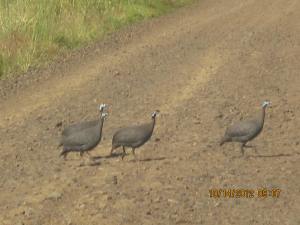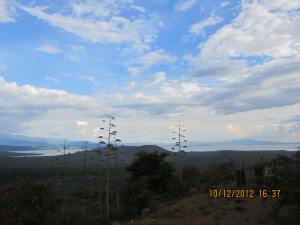
“Bridge of God” (an isthmus between Lakes Abaya and Chamo)
Left: Lake Abaya
Right: Lake Chamo
My southern Omo journey would not be complete without a safari trip to the Nechisar National Park to see the wild animals. (“Safari” is a Swahili word meaning journey/hunting expedition in eastern Africa). Nechisar (means white grass in Amharic) National Park is located near Arba Minch in the Southern Rift Valley, with the undulating Nechisar plains, hosting lakes Abaya and Chamo.
Going to the Nechisar Plains was anticipated to be a tough journey. The 20km from the entrance of the park to the plains was merely a dirt road, meandering through thick canopied forests and waterlogged marshland. At times, the dirt road did not even exist. The 4×4 was left to climb rocks and boulders, ascending and descending mountains, and treading across streams and rivers.

Lake Abaya – a beauty of its own kind
It is the largest “rift valley lake” in Ethiopia. (NB Lake Tana in Bahir Dar where I live is the largest lake in Ethiopia) It’s unique red hue is particularly eye catching, especially when seen side by side with Lake Chamo, which has a clear, tranquil blue surface. The red color is caused by heavy load of iron suspension.

Lake Chamo
Another rift valley lake nestled quietly in the Omo valley. Due to time limitation, I did not take the boat to see hippos,crocodiles and pelicans, which was an activity I dearly missed. Most tourists will prefer to take the scenic boat ride while I had taken the road less traveled.
It was only on the second attempt that we successfully reached our destination. We had to head out very early before dawn. Our first undertaking at the Nechisar National Park was aborted after one and a half hours of bumping up and down the narrow trail. Our road was blocked by another tourist 4×4 vehicle, which was stuck and decided to turn back. It had rained the night before. My experienced driver also considered the danger of the slippery boulders and sinking mud unsafe to proceed further. For the next few days, I was praying faithfully for the sun to dry up the road.
My strong passion to see the wild animals could be demonstrated by my insistence to return to the park and determination to conquer the challenges. My safari dream could not be achieved without the support and expertise of Seid, my driver. I felt so thankful to have him as a comrade on this journey. There had been so many moments that we were all holding our breaths and I was clinging tight onto my seat. I swear I did not wet my pants though!
This is a river I will never forget, a place where I had my first encounter with the gigantic biting tsetse flies (or tik tik flies). Tsetse flies are the vectors that carry trypanosomes, which can cause the deadly sleeping sickness in humans and nagana (animal trypanosomiasis) in game animals. They have the characteristic resting posture of holding back their wings (like a person holding back his arms on the back). The flies were swarming over our car, following us through the jungle.
The different responses of my “exploration team” at this spot vividly showed the different personalities of each individual.
It had been several days we did not have proper access to tap water. Driver Seid stopped at the river and gave his beloved vehicle a thorough wash and wipe. His act was important to ensure a clear view of windows and mirrors for safe driving. The windows of the car were shining so spotlessly clean that I could even see the veins on the wings of the tsetse flies. This made the flies look more horrifying. In addition, he bottled up more water for future use.
Believe it or not, Abush, the chubby tour guide, stripped naked right in front of our eyes and plunged into the river for a bath. He was taking all his time to enjoy the freshness of the water, only to regret that he was a “conspicuous” target of the hungry tsetse flies. He got bitten on his big toe!
You can call me a coward, but there is no way anybody could bribe me out of the car. Despite I was steaming hot and my body covered entirely with sweat, I had all the windows rolled up to stay out of harm’s way. Besides, I couldn’t care less whether my body smelled or not. I simply did not have the courage to bathe open in public.

Smile of triumph arriving at the Nechisar Plains. You can imagine how challenging the road had been. The 20km journey had taken nearly 3 hours.
I was immediately cautioned about ticks in the tall grass by my guide. Ticks can transmit typhus and other diseases. He also meticulously helped me search for bite marks and any hidden ticks in my jeans and boots after the expedition.
The Nechisar National Park is home to a large number of animals and birds: antelopes, hartebeest (endemic to Ethiopia), Grant’s gazelles, greater and lesser kudus, dik diks, Burchell’s zebras, black and white Colubus monkeys, olive baboons, bush bucks, bush pigs, warthogs, hippos, crocodiles, crested francolins, doves, white pelicans, white brow sparrows, gray back fiscals,… just to name a few. I was lucky to come face to face with many of them almost within arm’s reach. Sometimes I wish my little “point and shoot” camera could respond faster and capture all these wonderful creatures created by God with vibrant colors, interesting shapes and bold patterns. Some of the animals and birds are endemic only to Africa. I realized my knowledge about animals and birds was extremely limited. Often I had to look up their names retrospectively. Flamboyant colored butterflies and dragonflies painted an magnificent scene every time our car splashed over a puddle. Startled from their romance, the insects swarmed and rendezvoused over our car, fluttering their beautiful wings. Numerous species of fish live in the rift valley lakes. I had the chance of tasting the big hefty Nile perch for dinner after the trip.

Two warthogs bucking heads, opposing each other obstinately.
They were charging forcefully at each other for quite a long while with no one able to proceed forward.
How many times do we see this in human beings too?
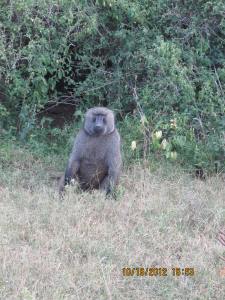
Same baboon posing for my camera after given a banana.
Picture looks familiar? (Mentioned earlier in my blogs: tribal people posing for photos after monetary or other material rewards)
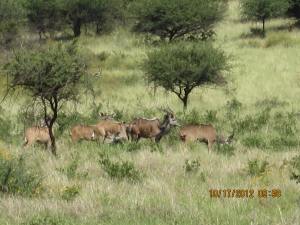
Greater Kudu
Both the greater kudu and its close cousin the lesser kudu have stripes and spots on the body, and most have a chevron of white hair between the eyes.
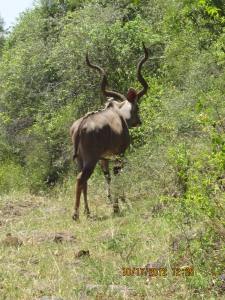
Male Greater Kudu
The greater kudu’s horns are spectacular and can grow as long as 72 inches, making 2 1/2 graceful twists. This male chauvinist was proudly leading our car for at least half a kilometer before rejoining his herd
You must wonder, how come I was walking so freely on the Nechisar Plains watching wild animals without the fear of being attacked by the lions? Where has the lion gone? That was a very good question. Due to overhunting by the tribes living in the national park and poor conservation, many of the large mammals, including the lions, giraffes and elephants, have extincted on the plains . This was evidenced by the victory waka poles on the graves of the tribal heroes documenting how many lions they had killed in their lives. In 1998, a blogger described he could still hear the roar of the lions in the vicinity of his hotel. Today, the tour guide told me there was only one lion left in Nechisar National Park. I suspected this was a “fact” he made up to lessen my disappointment. He said there might still be some of these large mammals in the Omo National Park, which was hardly accessible by car. The only way to get there was either by rafting or by foot. Otherwise, I need to visit them in the safari in Kenya or Tanzania.
Thus, the awards from my African safari trip was definitely not the prize of a hunted lion (or I should say the fortune of not being devoured by a lion) but the joy of the intimate encounter with Nature, the thrill and excitement of the adventure, and the pride of overcoming challenges all along the way.


